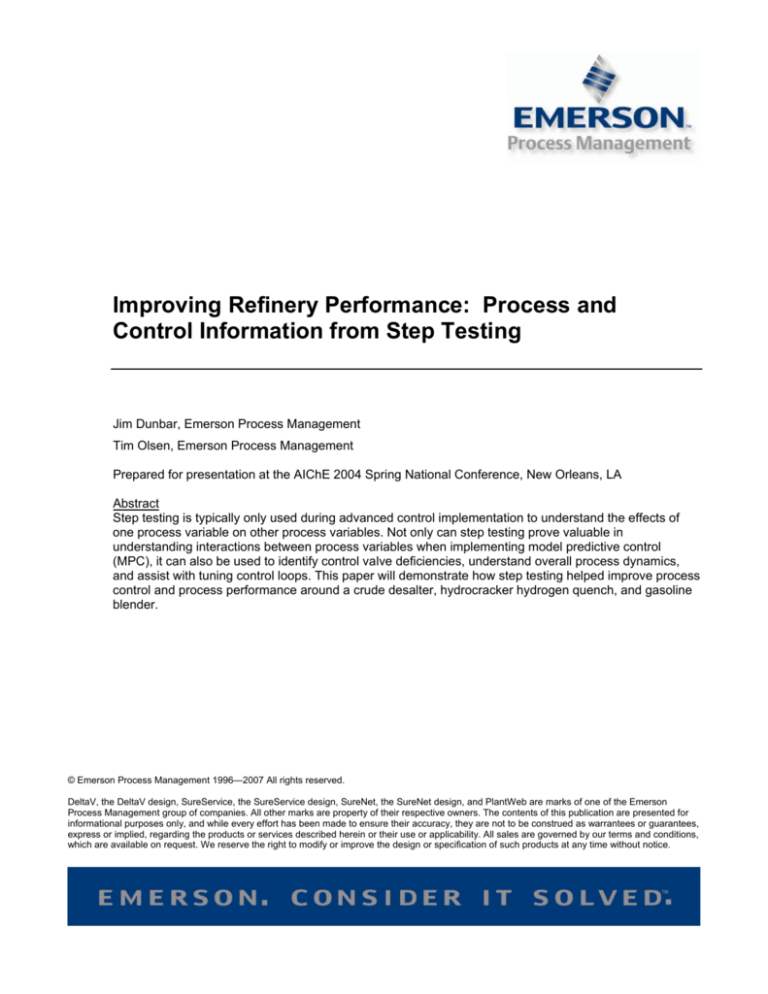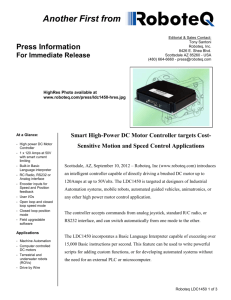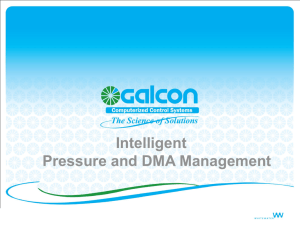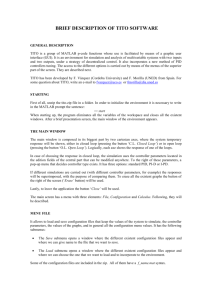
Improving Refinery Performance: Process and
Control Information from Step Testing
Jim Dunbar, Emerson Process Management
Tim Olsen, Emerson Process Management
Prepared for presentation at the AIChE 2004 Spring National Conference, New Orleans, LA
Abstract
Step testing is typically only used during advanced control implementation to understand the effects of
one process variable on other process variables. Not only can step testing prove valuable in
understanding interactions between process variables when implementing model predictive control
(MPC), it can also be used to identify control valve deficiencies, understand overall process dynamics,
and assist with tuning control loops. This paper will demonstrate how step testing helped improve process
control and process performance around a crude desalter, hydrocracker hydrogen quench, and gasoline
blender.
© Emerson Process Management 1996—2007 All rights reserved.
DeltaV, the DeltaV design, SureService, the SureService design, SureNet, the SureNet design, and PlantWeb are marks of one of the Emerson
Process Management group of companies. All other marks are property of their respective owners. The contents of this publication are presented for
informational purposes only, and while every effort has been made to ensure their accuracy, they are not to be construed as warrantees or guarantees,
express or implied, regarding the products or services described herein or their use or applicability. All sales are governed by our terms and conditions,
which are available on request. We reserve the right to modify or improve the design or specification of such products at any time without notice.
Introduction
This paper is intended to encourage process control engineers to understand the
dynamics of their processes and use this information to improve process control
performance. Step testing is a simple and inexpensive tool that every control
engineer should utilize.
A step test is when you place a controller
in manual and change the output a small
percentage so as not to significantly upset
the process and then observe the
response in the process variable. As
shown on the right in Figure 1, the
response can be the most common type,
a first-order plus dead time response.
There are many types of responses that
could be observed such as integrating,
second order response, inverse response
and others. This paper will address the
first-order plus dead time response.
100%
A
98%
f (t )
63%
0%
Td
T63
Time
τ
T98
Figure 1: First order with
deadtime response
Traditional Step Testing and Model Predictive Control (MPC)
In order to implement MPC on a process, one must first go through a series of
moves on each manipulated variable to determine the effects on all controlled
variables and the time-to-steady-state. The manipulated variables should be
moved in both positive and negative directions from the current operating point to
observe the process response. The data collected in the manipulated variables
are fit to algorithms in order to generate a dynamic model that best represents
the current process operation around the tested operating conditions (design
conditions versus turndown rates).
Control Valve Deficiencies
Before beginning any process control optimization program or implementing
MPC, one should first look at field device performance and deficiencies. A
simple and inexpensive first phase is to execute step tests on each manipulated
variable to determine the performance of the final control element. The size of
the output step should be large enough to observe the response above any
process noise that may be present, yet small enough to minimize process
upsets.
To test the performance of a control valve, put the controller in manual and begin
with small steps in one direction. Ensure you understand the process before
executing step tests to prevent unwanted process upsets (for example, do not
reduce hydrogen quench flow to cause a hydrocracker reactor temperature
runaway;
start
with
increasing
hydrogen and then changing direction
back to normal hydrogen use). Start
with small steps such as 0.25%, 0.50%
or 1% depending on sensitivity of the
process. If you do not see a change in
flow/temperature/pressure,
continue
making step changes until you do see
a change. It is not uncommon to see
control loops requiring an output
change in excess of 2% to see
changes from the final control element
movement (Figure 2 above shows a
limit cycle due to a sticky valve).
Under-performing field devices add
process constraints that cannot be
tuned out or compensated with MPC.
55
Flow PV
54
53
52
%
51
50
49
48
Controller Output OP
47
0
500
Time seconds
Figure 2: Limit cycle in a flow loop
due to a sticky valve
Overall Process Dynamics and Assistance in Tuning Loops
Step tests can be a useful tool in determining overall process dynamics and timeto-steady-state. This information can be used in MPC and to assist in non-MPC
tuning. The primary process dynamic information attained from a step test is
steady-state process gain, dead time, and the time constant. Typically these
parameters are an average of several step tests around the normal operating
range.
The steady-state gain can
be calculated by taking the
measured process response
before and after the step
test and then dividing by the
output change. The time
constant Tau is the time
required to reach 63.2% of
the final process change.
The dead time is the amount
of time after the step test is
made until the process
actually begins to move.
See Figure 3.
Figure 3: Typical first order step response
Once an engineer understands the process dynamics, model-based tuning such
as Lambda Tuning can be applied to set the speed of response for each
1000
controller based on operating objectives and priorities. “Lambda Tuning” refers
to tuning methods where the control loop speed of response is a selectable
tuning parameter; the closed loop time constant is referred to as “Lambda” (λ).
Lambda Tuning originated with Dahlin [1] in 1968; it is based on the same IMC
theory as MPC [2, 3]. It is model-based and uses pole-zero cancellation to
achieve the desired closed loop performance. A recommended Lambda starting
point to ensure robustness is three times the larger of Tau or Deadtime. The
time for the loop to reach setpoint is approximately four times the selected
Lambda value.
Self-Regulating Process (First-order with deadtime model, Classical PID) [3, 4]
τ = time constant (from step test)
Td = dead time (from step test)
Kp = steady state process gain (from step test)
λ = closed loop time constant (Lambda – user defined speed of response)
Controller Settings
Tr = τ
Kc = (1 / Kp) * Tr / (λ + Td)
Crude Desalter (Decoupling Loop Interactions without MPC)
For a refiner, a difficult task is to tune the flow and pressure controllers around a
desalter so that they do not fight one another. These controllers have long time
constants and long delay times before action sees the measured variable.
Tuning-by-feel often results in de-tuning one controller to the point it is similar to
being in manual operation. By understanding the process dynamics of each
control loop and the overall process operating objectives, one can ensure the
loops can be tuned to maximize loop performance while minimizing the tendency
of the two loops to fight each other in closed loop control.
Here are the dynamics for one refiner’s desalter.
PVC
Pressure Control Valve
FVC
Flow Control Valve
PT
Downstream Pressure
Gain 0.87 %/%
Delay 15 sec.
Tau 20 sec.
Gain -0.4 %/%
Delay 11 sec.
Tau 30 sec.
FT
Upstream Flow
Gain 0.24 %/%
Delay 15 sec.
Tau 30 sec.
Gain 0.2 %/%
Delay 25 sec.
Tau 35 sec.
One refiner had difficult interactions between the pressure and flow controller
around their desalter that resulted in a pressure change of –7 psig from setpoint
when the flow increased 1% from normal. This was an operation issue when
decreasing flow rate since the pressure increased and lifted the relief valve on
the desalter vessel. A standard
procedure for the board operator
was to manually manipulate the
pressure control valve when
reducing feed rates to avoid lifting
the relief valve. Figure 4 shows
the 20-psig pressure change
related to a 3% increase in feed
rate. The tuning was changed
with a 30-second Lambda value
for the pressure controller and a
240-second Lambda value for the
flow controller. The end result is
displayed in Figure 5 with a 3%
change in feed rate, yet the
pressure only changed 6-psig (a
67% reduction in variation from
setpoint). Flow rates could be
changed and the pressure
controller
could
remain
in
automatic without lifting the relief
valve.
A simple rule used in cascade
control loops is to have the inner
control loop tuned 5-10 times
faster than the outer loop. The
same rule is used to decouple
interacting control loops not used
in MPC.
The most important
control parameter, the desalter
pressure, will be tuned 5-10 times
faster than the crude flow
controller.
Figure 4: Desalter Flow and Pressure
Interactions
Figure 5: Desalter Flow and Pressure
De-Coupled
Hydrocracker Hydrogen Quench (Detecting Hardware Deficiencies)
A refiner was experiencing +/-3 °F control on a reactor bed temperature control
via a hydrogen quench. No matter what tuning was used, the performance of the
controller could best control within +/-3 °F. As shown in Figure 6, the problem
was not the tuning but the resolution of the control valve.
Figure 6: Limit cycle in Rx Bed Quench Temperature due to 3% valve stiction
The hydrogen quench control valve was repaired with less friction packing and a
new two-stage positioner which resulted in much tighter control around the
hydrocracker reactor bed temperature. The controller was re-tuned and the
temperature control is observed below in Figure 7. The temperature set point
was increased slightly with the improvement in control without additional
hydrogen required.
Figure 7: Reactor Bed Quench Temperature Control after improving valve
performance
Gasoline Blending (Making Component Dynamics Perform the Same)
Many refiners use fudge factors on their gasoline blends based on experience to
account for non-linear octane blending. These compensating factors only work
well if no additional field device deficiencies or additional non-linear behaviors
exist for each blend component controller. In this application, it is desirable for all
of the blend components to have the same dynamic response to maintain a
consistent blend even when the components are ramped up or down.
For example, here is one refiner’s gasoline component blend control system
along with a description of each component dynamics (determined from step
testing):
Component
Line Size
Valve Size
Valve Type
Gain
Dead Time
(sec.)
n-Butane
Isomerate
Reformate
Cat Gas
Alkylate
Back
Pressure
3
3
4
6
3
6
3
3
3
4
3
6
Equal %
Linear
Linear
Equal %
Equal %
Equal %
0.95
0.57
0.73
0.87
0.36
-1.10
2.0
2.5
3.0
2.3
3.2
2.3
Time
Constant
(sec.)
2.2
2.7
3.0
3.3
3.7
2.7
Tight control of the back pressure controller is desirable to maintain a consistent
upstream pressure on the blend flow valves which will stabilize the individual flow
controllers. Applying Lambda Tuning, the Back Pressure controller will be tuned
to a Lambda of 8 seconds (or 3 times the open loop time constant). To minimize
interaction between the backpressure and the flow controllers, it is necessary to
tune the flow controllers at least 5 times slower than the pressure controller.
Here, each of the flow controllers will be tuned to the same Lambda of 40
seconds (5 times slower than the back pressure controller).
As a result of step testing, finding control element deficiencies and fixing them,
understanding the process dynamics, and applying the operation objectives to
determine desired speed of response for each controller, the primary benefits for
this refiner were as follows:
-
80% reduction in the number of off-spec blends (already had a blend
optimization package implemented)
Cost avoidance related to additional lab samples for off-spec blends
Better inventory management (less off-spec taking up storage)
Demurrage avoidance (again due to off-spec blends)
Octane target shifted from +0.2 above specification to +0.1
Repeatable process control operation to learn non-linear octane
blending characteristics
Total octane and RVP giveaway reduced from approximately
$250K/month to less than $50K/month.
Conclusions
Process control engineers have the ability to understand more about the
dynamics of their processes and then use this information to improve process
control performance. Step testing is a simple and inexpensive tool that every
control engineer can utilize. It can be used to identify control valve deficiencies,
understand overall process dynamics, and assist with tuning non-MPC control
loops.
REFERENCES
1.
2.
3.
4.
Dahlin E.B., Designing and Tuning Digital Controllers, Instr and Cont Syst,
41 (6), 77, 1968.
Morari M. and Zafiriou E., Robust Process Control, Prentice Hall, 1989.
Chien I-Lung and Fruehauf P.S., Consider IMC Tuning to Improve
Controller Performance, Hydrocarbon Processing, Oct. 1990.
J. Martin, A.B. Corripio and C.L. Smith, How to Select Controller Modes
and Tuning Parameters from Simple Process Models, ISA Transactions,
Vol 15, April 1976, pp 314-319.
For more information:
For more information on Variability Management please visit our website
www.EmersonProcess.com/solutions/VariabilityManagement , or
Contact us at:
email: AAT@emersonprocess.com
phone: +1 512-832-3575
Emerson Process Management
12301 Research Blvd.
Research Park Plaza, Building III
Austin, Texas 78759 USA








